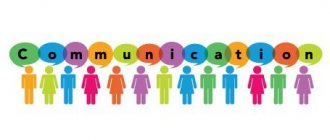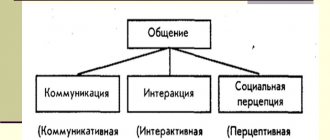Updated July 22, 2021 895 Author: Dmitry Petrov
Hello, dear readers of the KtoNaNovenkogo.ru blog. It is difficult to imagine a person’s day without at least some type of communication.
After all, this is not only necessary to resolve issues and achieve goals, but also to satisfy the needs of man as a rational being.
But what is communication: a simple exchange of words, or a more complex aspect in our lives? Is conversational skill a talent that some people have, or can it be developed? How important is it to talk to people, or can you do without it? Let's figure it out.
Communication is...
Communication is a connection between people, during which psychological contact appears. It manifests itself in mutual influence, -understanding, -experience, and in the exchange of information, thoughts, ideas, emotions.
In the modern world, the scale of data that needs to be urgently transferred to someone has increased significantly. Therefore, the intensity and importance of communication increases, and along with this, the methods for implementation (messengers, video calls, etc.).
Communication in psychology is 3 important aspects that are intertwined:
- The purpose is the reason for which contact and information transfer occur.
Animals that also communicate can transmit an alarm signal to warn that danger is nearby. Or for the primitive attraction of a sexual partner. Thus, they satisfy their biological needs. As for a person, communications can be cultural, social, aesthetic, creative, cognitive - for the growth and development of the individual. - Content - This is the data that is transmitted during communication. In the animal world, this is, for example, information that there is food nearby.
For people, the object of conversation can be very different. May include a skill or experience, feelings that are conveyed to each other.
- Media is a way of transmitting information.
Because communication is not only words and the use of language (what is it?), writing. Signals can also be transmitted using smells, a visual component, or by touching another person.
Classification of species: table
What types of communication are there? Every person uses different types of communication in their life. Their classification occurs according to various criteria. The following main types of communication are distinguished:
| Classification criteria | Types of communication and their characteristics | Examples of communication |
| Types of communication by content | Material. Participants in communication interact with each other in order to obtain material benefits, some objects, or products of work. | Purchasing goods in a store. |
| Cognitive . Communication with the aim of transmitting or receiving any developmental information necessary for cognition and self-improvement. | Communication between a student and a teacher in class. | |
| Activity . Exchange of skills or abilities between participants. | Communication with a trainer in the gym. | |
| Motivational . Transferring incentives and motivation for any activity. | Motivational trainings in marketing companies. | |
| Air-conditioned . Intentional influence on the psychological state to achieve a specific result. | Communication between the swindler and the victim. | |
| Types of communication by purpose | Biological. Communication to satisfy biological needs. | Communication for the purpose of obtaining sexual release. |
| Social . Communication to satisfy human social needs. | A poet's performance in front of an audience with the goal of gaining universal recognition. | |
| By means of expression | Verbal. Communication using speech. | Any communication that involves direct speech. |
| Nonverbal . Communicating with body language. It can act both as independent elements of communication and as a complement to types of verbal communication. | Gestures, postures, facial expressions , body tilts . | |
| By communication participants | Interpersonal. Implies direct contact of its participants. | One-on-one conversation on personal topics. |
| Personal-group . Communication with each group member. | Meeting between manager and subordinates. | |
| Intergroup . Communication between several groups of people. It can be either peaceful or conflictual. | Ethnic hostility. | |
| By means of information transmission | Indirect. Communication using technical means. | Correspondence via messenger, email or through a mutual friend. |
| Direct . Communication between two participants in close proximity to each other. | One-on-one conversation. | |
| By time | Short term. Communication is short in time, usually not implying repeated contact. | Conversation with the cashier at the ticket office. |
| Long lasting. In the process of communication, participants not only exchange necessary information, but also get to know each other. Assume continuous or periodically interrupted contacts. | Communication between a young man and a girl who are about to tie the knot. |
Communication functions
Although we understand the importance of relationships with other people, it is not always possible to grasp all the functions of communication. Psychologist V.N. Panferov identified 6 main points:
- communicative – interaction of people at different levels – from individual to social;
- cognitive – understanding of the transmitted information;
- informational – exchange of data between each other;
- creative – the formation of new connections between people, their development;
- conative – leadership and fulfillment of roles in relation to each other;
- emotive – emotional contact between people.
In other sources you can see a classification into 4 functions:
- syndicative – an association of people;
- instrumental – transmission of information, a way of managing society;
- translational - transfer of judgments, assessments, methods of activity;
- self-expression is an opportunity to show and present oneself to others, for mutual understanding.
Or a more concise and generalized division:
- socialization – education of interaction skills in society (what is this?); mastering rules and regulations;
- control of society - organization of people's behavior and work;
- expressive function – understanding the emotions, feelings, experiences of others.
Components: briefly
What are the components of communication? Psychologist G. M. Andreeva proposed a division of communication into the following components, regardless of what functions it performs and what goals it pursues:
- communication side, exchange of information between participants,
- interactive side, interaction of participants,
- perceptual side, mutual understanding between participants.
Communication of any type contains one or all of the listed components.
Forms of communication
Characterizing communication, forms are its important feature and description. They depend on the purpose and content of communication. You can identify a large number of forms that complement each other and intertwine with each other.
But there are more typical and common options:
- Functional-role communication is communication during which people occupy specific social roles (what is this?). For example: driver – passenger, teacher – student, manager – subordinate.
- Informal communication is communication between people in an informal atmosphere. The simplest example is communication between relatives, friends, couples or spouses, and neighbors. It can also happen between work colleagues when they go out to lunch together and talk freely about various topics.
- Anonymous – exchange of information between people who enter into casual communication. At the same time, I do not identify myself, or provide a small amount of data (name, profession). These strangers could meet and talk in public transport, at an art exhibition, in an elevator, in a cinema, in an anti-cafe.
They enter into a dialogue that was formed randomly - faceless in front of each other. And then the short relationship is broken.
Today, functional and anonymous communication is more common. The reason is the constant movement of people to new cities; large-scale development of service sectors; holding various lectures, webinars (what is this?), festivals.
Concept of speech
Speech is the process of communication between people using language. In order to be able to speak and understand someone else’s speech, you need to know the language and be able to use it.
In psychology, it is customary to separate the concepts of “language” and “speech” (Table 2).
Language is a system of signs and symbols with the help of which combinations of sounds that have a certain meaning and meaning for people are transmitted. Language is developed by society and is a form of reflection of their social existence in the public consciousness of people. Language, being formed in the process of communication between people, is at the same time a product of socio-historical development.
table 2
The meaning of speech and language (psychological aspect)
| Speech | Language |
| Forms human consciousness Opens up the consciousness of another person for us Makes available to individual consciousness the experience of all humanity Brings human consciousness beyond sensory experience | Doubles the world for a person, as it makes it possible to perform actions with objects even during their absence Makes it possible to evoke images regardless of their real existence Controls human intellectual processes: perception, memory, thinking |
Speech is a form of communication that has developed historically in the course of the material transformative activities of people, mediated by language. Thus, speech is the realization of language, which reveals itself only through speech. Human speech arises in response to the need to communicate with someone or communicate something.
Speech is closely connected with all aspects of human consciousness. Speech is a factor in a person’s mental development, his formation as a personality. All mental processes with the help of speech become voluntary and controllable. Speech is a mental phenomenon, it is individual and bears the imprint of a given individual’s subjective reflection and expression of objective reality and attitude towards it.
Types and levels of communication
If we characterize the forms more precisely, we will get such a concept as “ types of communication .” This classification describes the relationship, giving it bright and specific features:
- Primitive - when people look at the interlocutor as an object on whom they label “can be used / not needed.” And in accordance with this, they try to improve relationships, or they leave the dialogue, avoid it.
- Formal-role – when the method of communication, its essence and content is established. The social function of a person in a particular group plays an important role.
- “ Contact of masks ” - the usual hypocrisy (what is this?), insincerity or simply politeness is used without the desire to understand the interlocutor. The connection is formed exclusively on a superficial and formal level.
- Business - during a conversation, they focus on the matter, the issue. But at the same time, they can pay attention to some of the partner’s traits and take into account their character. Everything in order to achieve your goal.
- Manipulative - different methods are used to get benefits from the interlocutor (ostentatious indifference, false haste, assertion of authority).
- Secular - people do not express their real point of view, but simply talk about nothing. As a rule, the purpose of such chatter is to meet profitable people and to show off oneself to others.
- Spiritual – when the interlocutors know each other’s personalities well. When communicating, they take into account interests, preferences, and can suggest reactions to words.
Types provide a more diverse description of communication. Levels describe the attitude of people within the framework of communication. Researcher V.N. Sagatovsky highlights:
- The level of manipulation is the attitude and treatment of people as an object to achieve a goal.
- The level of “ reflexive play ” - a person in a dialogue understands that both have plans for each other. But they are trying to show that they just have normal communication without pitfalls.
- Level of legal communication - the behavior of the interlocutors is coordinated, taking into account specific rules and norms.
- Level of moral communication - the relationship arises on the basis of the unity of internal qualities.
Physiological basis of speech
The physiological basis of speech is illustrated in Fig. 5.
Peripheral speech support systems include:
- the energetic system of the respiratory organs necessary for the production of sound - the lungs and the main respiratory muscle - the diaphragm;
- generator system - sound vibrators (vocal cords of the larynx), the vibration of which produces sound waves;
- resonator system - nasopharynx, skull, larynx and chest.
Syntagmatic and paradigmatic mechanisms of speech
Mechanisms
speech perception
Mechanisms for organizing speech response
Peripheral speech support systems: energy, generator, resonator
Second signaling system
Brain speech centers
Speech
Speech functions of the left hemisphere of the brain
Rice. 5. Physiological foundations of speech
According to the teachings of I.P. Pavlov, in humans there are two signaling systems of stimuli: the first signaling system is the direct impact of the internal and external environment on various receptors (this is also present in animals) and the second signaling system (speech). Moreover, only a small part of these words denotes sensory effects on humans. The work of the second signaling system consists primarily in the analysis and synthesis of generalized speech signals.
Special studies have established that a person’s ability to analyze and synthesize speech is associated with the left hemisphere of the brain. There are four brain speech centers: Brocca's center (located in the superior frontal gyrus), responsible for the volume of speech pronunciation; Wernicke's center (located in the temporal gyrus) - associated with understanding the meaning; visual center (located in the occipital lobe) – associated with the reading process; writing center (located in the middle frontal gyrus) – associated with written speech.
In addition, speech is ensured by the functioning of certain physiological mechanisms.
Syntagmatic and paradigmatic mechanisms of speech. Syntagmatic mechanisms reflect the dynamic organization of a speech utterance and its physiological characteristics during the functioning of the cerebral cortex. Paradigmatic are responsible for connecting the posterior parts of the left hemisphere with speech codes (phonemic, articulatory, semantic, etc.).
Mechanisms of speech perception. The transition to understanding the speech message is possible only after the speech signal has been converted. It is analyzed on the basis of detector coding, the phonemic interpretation of the information received by the brain. This means that neurons are sensitive to different sound signals and act on the basis of building a certain model of word recognition.
Mechanisms for organizing speech response. In an adult who speaks language, perception and pronunciation are mediated by internal physiological codes that provide phonological articulatory, visual and semantic analysis of words. Moreover, all of the above codes and the operations carried out on their basis have their own cerebral localization.
The complex process of verbal communication is based on the sequential activation of the mechanisms that provide it.
The first stage in the formation of speech structures is speech programming - building the backbone of a speech utterance. For this purpose, important information is selected and unnecessary information is eliminated.
The second stage is the construction of the syntactic structure of the sentence. The general structure of the phrase and its grammatical form are predicted, mechanisms are activated to ensure the search for the desired word, and the selection of sounds that most accurately reproduce it. Finally, pronunciation, the actual sound of speech, takes place. Thus, the process of “speaking” unfolds, during which the communicator encodes the information to be transmitted.
During the listening process, the interlocutor decodes the information received, which in turn is a step-by-step translation of the sounds of audible speech into the meaning of words, and this ensures an understanding of what the communicator wanted to say.
The art of communication
It seems to many that having a competent conversation is a difficult task that only a few can master. Some may feel shy about other people, or don't know how to continue a conversation.
But if you want to improve communication, psychology will help improve your skills (what is it?).
Sensitivity
The ability to sense the emotional state of your interlocutor is very important when talking. Not only developed empathy (what is it?), but also constant observation and study of people can help with this.
Observation
Separately, it is worth highlighting the perception of a person with his behavior, facial expressions, and position in life. This will give us an idea of what style to talk in so that communication is pleasant for both parties.
Memory
If we remember most of what a person told us, then we can refer to it and mention it in the next conversation. In this way we show that we are interested in him - this brings us much closer together.
Broad outlook
When your interlocutor talks about a topic that you are completely far from, you can listen and learn something new. Instead of stopping him and showing your lack of interest.
In addition, it is worth studying different areas in order to be able to carry on conversations with people from different backgrounds.
Language becomes a means of communication, a means of establishing mutual understanding for those who speak it.
At the same time, he becomes a means of isolation for those who do not know him.
In addition to the meaning common to all individuals, a sign can have its own subjectively colored personal meaning for each person. It is generated by a person’s personal experience, his desires, hopes, fears, and other feelings.
In the afterword to L. S. Vygotsky’s work “Thinking and Speech,” his associate A.R. Luria speaks of the meaning of a word as an “internal meaning”, which “... the word has for the speaker himself and which constitutes the subtext of the utterance. The words “Carriage for me, carriage!” does not at all mean that Chatsky points to the carriage and asks for it to be brought. The internal meaning of the statement is that Chatsky is breaking with a society that is unacceptable to him, and the hero’s exclamation is not at all a conveyance of a specific event, but a “clump of meaning” that stands behind it.
When communication is formalized, the most important thing about people's words and actions is their generally accepted meaning. In order to ensure accuracy in recording these meanings, lawyers, diplomats and scientists take care of the rigor of wording in their professional activities.
In principle, this is very important in any professional field of activity. If in communication a person acts as an individual and expresses his own views and feelings, then for the interlocutor, in addition to the generally accepted meaning of behavior, its personal meaning becomes important.
We can say that we can understand a person as a bearer of a certain culture only by understanding the meaning of his words and actions.
From this point of view, signs are divided as follows:
intentional – specially produced to transmit information;
non-intentional - unintentionally giving out this information.
Non-intentional signs can be signs of emotions that a person would sometimes like to hide (for example, a student’s anxiety in front of an audience can be revealed by trembling hands, even if he has good command of his voice and face).
Speech can also contain non-intentional signs (for example, slips of the tongue in which the emotional state of the speaker is revealed). Non-intentional signs can contain information not only about the emotional state of the partner.
Thus, accent and subtle features of pronunciation can become an indicator of a person’s place of origin and life, as well as the social environment in which he was raised. Frequent references in a speech to the opinion of a person can show who the speaker is guided by in his judgments.
Since non-intentional signs primarily speak about the person himself, his immediate, spontaneous reactions, it is very important to learn to notice them and correctly decipher them.
** Brief psychological dictionary. – M., 1985. – P. 213
* Brief psychological dictionary. – M., 1985. – P. 420









